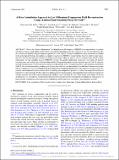A data assimilation approach to last millennium temperature field reconstruction using a limited high-sensitivity proxy network
Abstract
We use the Northern Hemisphere Tree-Ring Network Development (NTREND) tree-ring database to examine the effects of using a small, highly-sensitive proxy network for paleotemperature data assimilation over the last millennium. We first evaluate our methods using pseudo-proxy experiments. These indicate that spatial assimilations using this network are skillful in the extratropical Northern Hemisphere and improve on previous NTREND reconstructions based on point-by-point regression. We also find our method is sensitive to climate model biases when the number of sites becomes small. Based on these experiments, we then assimilate the real NTREND network. To quantify model prior uncertainty, we produce 10 separate reconstructions, each assimilating a different climate model. These reconstructions are most dissimilar prior to 1100 CE, when the network becomes sparse, but show greater consistency as the network grows. Temporal variability is also underestimated before 1100 CE. Our assimilation method produces spatial uncertainty estimates and these identify treeline North America and eastern Siberia as regions that would most benefit from development of new millennial-length temperature-sensitive tree-ring records. We compare our multi-model mean reconstruction to five existing paleo-temperature products to examine the range of reconstructed responses to radiative forcing. We find substantial differences in the spatial patterns and magnitudes of reconstructed responses to volcanic eruptions and in the transition between the Medieval epoch and Little Ice Age. These extant uncertainties call for the development of a paleoclimate reconstruction intercomparison framework for systematically examining the consequences of proxy network composition and reconstruction methodology and for continued expansion of tree-ring proxy networks.
Citation
King , J M , Anchukaitis , K J , Tierney , J E , Hakim , G J , Emile-Geay , J , Zhu , F & Wilson , R 2021 , ' A data assimilation approach to last millennium temperature field reconstruction using a limited high-sensitivity proxy network ' , Journal of Climate , vol. 34 , no. 17 , pp. 7091-7111 . https://doi.org/10.1175/jcli-d-20-0661.1
Publication
Journal of Climate
Status
Peer reviewed
ISSN
0894-8755Type
Journal article
Description
Funding: The authors acknowledge support from the Climate Program Office of the National Oceanographic and Atmospheric Administration (NOAA grants NA18OAR4310420 to KJA, NA18OAR4310426 to JEG and FZ, and NA18OAR4310422 to GJH). GJH also acknowledges support from the NSF through grant AGS–1702423. JMK was partially supported by NSF grant AGS-1803946. JET and JMK acknowledge support from NSF grant #AGS-1602301 and Heising Simons Foundation grant #2016-05.Collections
Items in the St Andrews Research Repository are protected by copyright, with all rights reserved, unless otherwise indicated.

